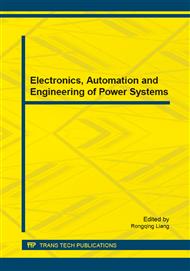[1]
E. O. Torres, and G. A. Rincon-Mora, Energy-harvesting system-in-package (SiP) micro system, ASCE Journal of Energy Engineering, vol. 134, no. 4, pp.121-129, Dec. (2008).
Google Scholar
[2]
C. Bergonzini, D. Brenelli, and L. Benini, Algorithms for harvested energy prediction in battery less wireless sensor networks, in Proc. 3rd IWASI, pp.144-149, (2009).
DOI: 10.1109/iwasi.2009.5184785
Google Scholar
[3]
M. G. villalva, J. R. Gazoli, and E. R. Filho, Comprehensive approach to modeling and simulation of photovoltaic arrays, IEEE Trans. Power Electronics, vol. 24, no. 5, pp.1198-1208, May. (2009).
DOI: 10.1109/tpel.2009.2013862
Google Scholar
[4]
T. Esram, and P. L. Chapman, Comparison of photovoltaic array maximum power pint tracking techniques, IEEE Trans. Energy Conversion, vol. 22, no. 2, pp.439-449, Jun. (2007).
DOI: 10.1109/tec.2006.874230
Google Scholar
[5]
V. Raghunathan, A. Kansal, J. Hsu, J. Friedman, and M. Srivastava, Design considerations for solar energy harvesting wireless embedded systems, In Proc. 4th Int. Conf. on Information Processing in Sensor Networks, pp.457-462, Apr. (2005).
DOI: 10.1109/ipsn.2005.1440973
Google Scholar
[6]
D. Brunelli, L. Benini, C. Moser, and L. Thiele, An efficient solar energy harvester for wireless sensor nodes, in Proc. Conf. DATE, 2008, pp.104-109.
DOI: 10.1109/date.2008.4484670
Google Scholar
[7]
K. Kobayashi, H. Matsuo, and Y. Sekine, A novel optimum operating point tracker of the solar cell power supply system, in Proc. 35th Annu. IEEE power electronics Spec. Conf., 2004, pp.2147-2151.
DOI: 10.1109/pesc.2004.1355451
Google Scholar
[8]
S. Yuvarajan, and S. Xu, Photo-voltaic power converter with a simple maximum-power-point-tracker, in Proc. 2003 Int. Symp. Circuit Syst. 2003, PP. III-399-III-402.
DOI: 10.1109/iscas.2003.1205040
Google Scholar
[9]
J. H. R. Enslin, and D. B. Snyman, Simplified feed-forward control of the maximum power point in PV installations, in Proc. Int. Conf. Ind. Electron, Contr., Instrum., and Automat., 1992, pp.548-553.
DOI: 10.1109/iecon.1992.254498
Google Scholar
[10]
D. shmilovitz, On the control of photovoltaic maximum power point tracker via output parameters, in IEE Proc. Elect. Power Appl., 2005, pp.239-248.
DOI: 10.1049/ip-epa:20040978
Google Scholar
[11]
E. Koutroulis, K. Kalaitzakis, and N, C. Voulgaris, Development of a microcontroller-based, photovoltaic maximum power point tracking control system, IEEE Trans. Power Electronics, vol. 16, no. 21, pp.46-54, Jan. (2001).
DOI: 10.1109/63.903988
Google Scholar
[12]
H. Shao, C. Y. Tsui, and W. H. Ki, The design of a micro power management system for applications using photovoltaic cells with the maximum output power control, IEEE Trans. VLSI Systems, vol. 17, no. 8, pp.1138-1142, Aug. (2009).
DOI: 10.1109/tvlsi.2008.2001083
Google Scholar


